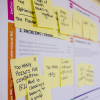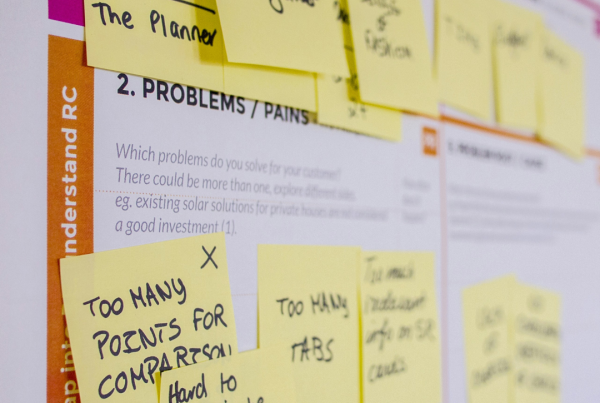Creating a product strategy takes time when there are so many unknowns about your product, especially if it’s new. But in business, you can’t afford to waste time.
It doesn’t matter how long it takes to develop a strategy; it’s how effective it is. Whether you take 6 months or 2 weeks, it’s about how well you can execute your plan and the impact.
After all, a product strategy is not static. It will evolve according to user feedback, market dynamics, industry regulations, and economic outlook. So why spend so much time on something that will change over time?
Part of my work involves helping clients work faster, zooming in on what matters, and iteratively delivering improvements based on user data, research, and feedback. In this article, I will explain how you can create a robust product strategy in two weeks to get to the design phase quickly.
Your Product Strategy Can Be Done in 2 Weeks
Having a product planning phase that takes months can stall momentum and lead teams down the wrong path. Endless meetings, over-researching, and indecision aren’t ideal, especially in competitive markets where user expectations evolve quickly. The longer it takes to gain clarity, the greater the risk of building something no one wants.
The solution I bring is a 2-week program that accelerates the development of your product strategy. Consisting of a design sprint, it helps you make decisions and foster stakeholder alignment quickly. Your organisation will be guided through a structured, high-intensity process to gather insights, prioritise opportunities, and produce a clear strategic direction.
The product strategy accelerator program is excellent for gaining clarity and formulating strategies when:
- Designing an early-stage product
- Revamping a product with poor user feedback
- Navigating a product pivot
- Your organisation is stuck, or teams are misaligned
Week 1: Product Research and Discovery
Your product strategy should be backed by cold, hard data and research, not guesswork.
In the first week, we’ll gather information, get stakeholders up to speed, and dig for relevant insights to inform the design sprint in the second week. Typically, we’ll conduct stakeholder interviews, study existing data and the market, and map out the user personas and customer journey.
Stakeholder interviews are a crucial starting point. Speak with leaders, product managers, sales, marketing, customer support, and engineers to understand their goals, assumptions, and constraints. These conversations will uncover misalignment early, identify risks, and clarify business priorities.
Next, it’s helpful to quickly audit your existing product (if you have one), market, and channels. Study competitors to understand their strengths, weaknesses, and spot market gaps.
You’ll also need to create or refine user personas. If you already have a customer journey map, you can identify bottlenecks, such as when users start to drop off to pinpoint where your product is lacking.
Lastly, gather inspiration and examples for your product that embody your business values and aspirations to build a standout product.
Week 2: Product Strategy and Prioritisation
Using the insights and data from the first week, we will now work to shape them into a clear product strategy, transforming the discovery into a high-level product strategy with actionable insights.
The second week is a strategic workshop, similar to a design sprint, that typically takes two days. Relevant stakeholders and cross-functional teams should be involved so everyone is on board early. The program is tailored to my clients’ needs, so no two programs are identical. Below is an overview of what is generally covered.
Defining the Product Vision
You must understand your product’s “why” to define a vision. Ask fundamental questions such as:
- What’s the problem you’re trying to solve?
- Who are you trying to solve the problem for?
- Has this problem been solved in any meaningful way by others?
- Is the problem you’re solving urgent?
- Is your solution something the user needs?
Product Ideation
We’ll focus on generating and refining ideas that solve your users’ problems. Using insights from the first week, we’ll conduct a series of structured sessions to guide the brainstorming process to avoid going off tangent.
At this stage, we won’t pay too much attention to feasibility and scalability as we want to gather many ideas and whittle them down to the best ones. The goal is to identify promising concepts that align with user needs and business objectives.
Product Prioritisation
You’ll understand your product’s value and the high-level strategy by this stage. Armed with a direction and the best ideas, we can start prioritising what matters the most and aligning those priorities with strategic goals and available resources. The goal is to deliver the highest-impact features first, focus on priorities, and use time and resources effectively.
Outcomes You Can Expect
By following this two-week program, you’ll gain:
- A high-level product strategy with a clear direction and insights backed by data
- Stakeholder alignment, where teams share the same vision, direction, and are ready to work together in the next phase
- A high-level customer journey map, storyboard, or product roadmap
The Bottom Line
Crafting a product strategy shouldn’t be a drawn-out process riddled with indecision. You can achieve clarity with relevant stakeholders in two weeks by focusing on what truly matters. Your team will feel empowered to act swiftly, mitigate risks early, and build products that users need.
If you’re interested in discovering a stronger strategy or need better stakeholder cohesion, reach out to learn more about my Product Strategy Accelerator program.







